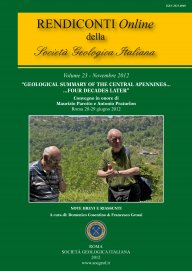
The Messinian Central Apennines
Domenico Cosentino (*,**) & Paola Cipollari (*,**)
(*) Dipartimento di Scienze Geologiche, Università degli Studi Roma Tre, Largo San Leonardo Murialdo 1, 00146 Roma.
(**) CNR-Istituto di Geologia Ambientale e Geoingegneria, Roma.
DOI: https://doi.org/
Volume: 23/2012
Pages: 45-51
Abstract
During the Neogene, the sedimentary wedge developed on the southern Neotethyan passive margin was involved in the evolution of a post-collisional orogenic system, consisting of a thrust- belt/foredeep couple migrating toward more external domains. In particular, during the post middle-Tortonian orogenic phases of the Apennines, the Adria microplate played a significant role. The boundary interaction between Adria and the surrounding continental plates controlled the evolution of the Adria-verging orogenic system. The geometry of the chain, the diachronism of the eastward migrating foredeep basins, and the different ages of the forethrusts are consistent with a regional forelandward propagation model for the central Apennines. In the central Apennines, more than 70% of the present chain was affected by compressional tectonics during the Messinian Salinity Crisis. In particular, the main deformational event happened at the end of the Messinian stage, during the deposition of the late Lago-Mare biofacies (5.45 – 5.33 Ma) throughout the Mediterranean Basin.
The end of the Messinian stage seems to represent a period of plate reorganization in the Mediterranean area, since many places were affected by horizontal shortening (Apennines) and strong uplift rates (Gibraltar strait, Anatolian plateau, etc.).
Keywords
Messinian salinity crisis, Messinian Lago-Mare event, Messinian tectonics, chain-foredeep migration, central Apennines
Get Full Text